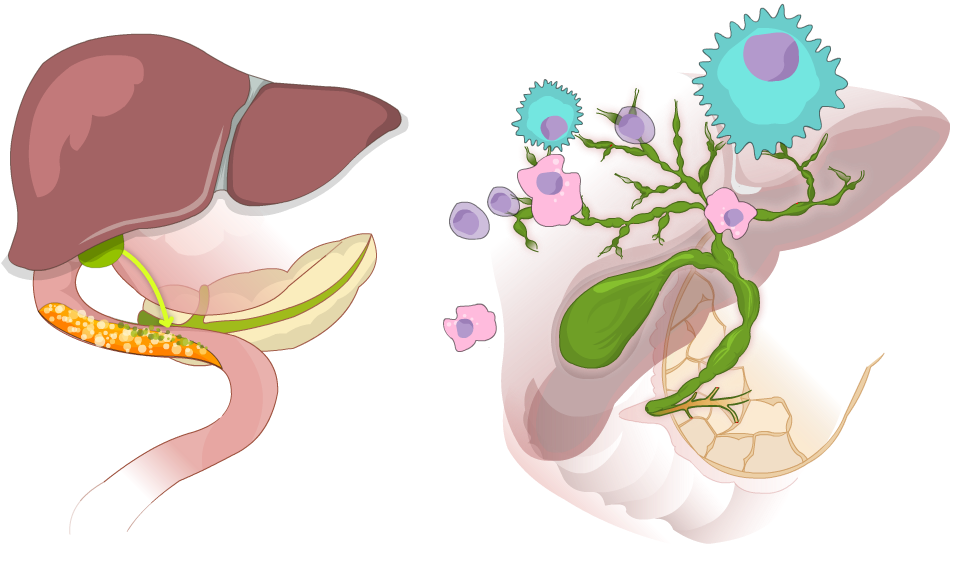Primary sclerosing cholangitis (PSC) is a liver disease that causes inflammation and scarring in the bile ducts, making them shrink over time. (Bile ducts are small tubes that bile flows through from within the liver to the gallbladder and intestines). This inflammation results from immune cells attacking the bile ducts. PSC is called “primary” because the cause is unknown, “sclerosing” because of the scarring, and “cholangitis” because the inflammation occurs in the bile ducts.
Bile is a yellow-green fluid produced by your liver to aid digestion. When bile ducts are damaged by inflammation and scarring (cholangitis), bile and other substances collect in the liver, which in turn damages liver cells.
PSC may sometimes be confined to the bile ducts within the liver, but most often it also attacks the large bile ducts outside the liver. The disease affects both sexes, but it’s more common in men. It occurs in people mostly between the ages of 30 and 50.

Symptoms
The progression of PSC is unpredictable and not well understood. A person can have the disease for many years before symptoms show. The most common symptoms include:
- Chronic fatigue. This can range from mild to disabling.
- Itching. Known medically as pruritus, itching can range from mild to intense. It can be relentless, disrupting sleep and quality of life. This itching usually attacks the whole body and may be the result of the liver’s inability to process bile.
- Jaundice. This refers to yellowing of the skin and eyes.
- Episodes of fever, chills, and abdominal pain. These may be signs of an infection within the bile ducts. Any patient with PSC who has fever and chills should go to the nearest hospital emergency room immediately.
In its advanced stages, PSC may lead to extensive scarring in the bile ducts and eventually, liver failure.
As liver damage progresses in PSC, other symptoms may appear. These can affect parts of your body outside your liver. These symptoms are the same as for advanced liver disease from any cause.
Diagnosis
Because people with PSC may have no symptoms for many years, PSC is often diagnosed when patients show abnormal results from standard blood tests. Additional diagnostic tests such as MRI (magnetic resonance imaging) or ERCP (endoscopic retrograde cholangiopancreatography) may be necessary to confirm PSC.
ERCP combines the use of X-ray and an endoscope, which is a long, flexible tube. Through this form of endoscopy, your doctor can see inside your stomach and duodenum and inject dyes into your bile ducts. This creates a high-quality X-ray that can show strictures (narrowing) caused by inflammation in your bile ducts.
Treatment
There is no specific treatment for slowing the advance of PSC. Unfortunately, PSC is relentless over time. It leads to liver failure and the need for liver transplant with almost all patients.
However, doctors can treat PSC symptoms with varying success using antibiotics, vitamins, and medications.
To help relieve itching (pruritus), a common symptom, your doctor may prescribe various medications such as cholestyramine, antihistamines, or other drugs such as naltrexone or rifampicin. For patients with extreme itching, doctors will occasionally prescribe ultraviolet light therapy.
Sometimes, doctors will use ERCP to dilate a stricture or insert a stent in the bile ducts. This may alleviate jaundice and other symptoms over the short term.
References:
The information on this page was adapted (with permission) from the references below, by the Cirrhosis Care Alberta project team (physicians, nurse practitioners, registered nurses, registered dietitians, physiotherapists, pharmacists, and patient advisors).
This information is not intended to replace advice from your healthcare team. They know your medical situation best. Always follow your healthcare team’s advice.
References:
